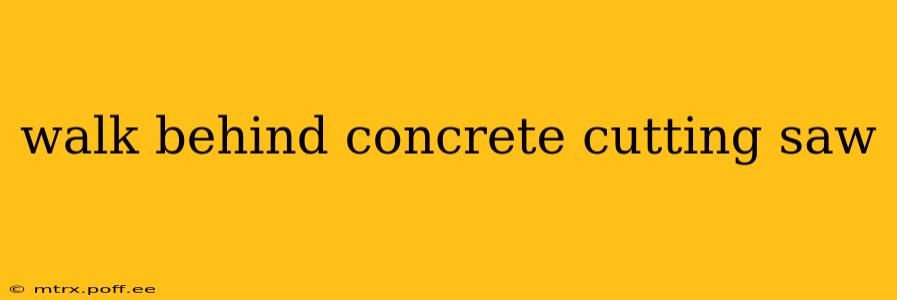Walk-behind concrete cutting saws are essential tools for various construction and demolition projects. Their ability to cut through thick slabs of concrete with precision makes them indispensable for professionals and serious DIY enthusiasts alike. This comprehensive guide will cover everything you need to know about these powerful machines, from choosing the right saw to ensuring safe operation.
What is a Walk-Behind Concrete Cutting Saw?
A walk-behind concrete cutting saw is a powerful piece of equipment designed to cut through concrete and asphalt. Unlike smaller, hand-held saws, these are larger, self-propelled machines that the operator walks behind while guiding the blade. They are typically equipped with a large-diameter diamond blade, capable of cutting through thick materials quickly and efficiently. They are used in a variety of applications, from creating precise cuts for expansion joints to demolishing entire concrete structures.
What are the Different Types of Walk-Behind Concrete Cutting Saws?
Several types of walk-behind concrete saws cater to different needs and budgets. The primary distinctions lie in the power source (gasoline or electric) and the cutting method (wet or dry).
Gasoline vs. Electric Walk-Behind Concrete Saws:
- Gasoline-powered saws: These offer superior power and are ideal for heavy-duty applications and larger projects where continuous operation is required. They are less restricted by power cords, allowing for greater mobility on larger job sites.
- Electric saws: Electric walk-behind saws are quieter, cleaner, and generally easier to maintain than gasoline-powered models. They are a good choice for smaller projects or indoor use where fumes and noise are a concern. However, they are limited by cord length and power availability.
Wet vs. Dry Cutting:
- Wet cutting: This method involves using water to cool the blade and suppress dust, making it safer and cleaner. It's generally preferred for larger cuts and prolonged use.
- Dry cutting: Dry cutting is faster and simpler, but it generates significant dust and can damage the blade more quickly. It is more suitable for smaller, less demanding jobs.
How to Choose the Right Walk-Behind Concrete Cutting Saw?
Selecting the appropriate saw depends on several factors:
- Cutting Capacity: Consider the thickness of the material you’ll be cutting. Thicker materials require saws with larger blades and more power.
- Power Source: Gasoline saws provide more power but are louder and produce emissions. Electric saws are quieter and cleaner but may lack the power for demanding tasks.
- Cutting Method: Wet cutting is generally safer and produces less dust but requires a water source. Dry cutting is faster but creates more dust.
- Budget: Prices vary significantly depending on the features and power of the saw.
What Safety Precautions Should I Take When Using a Walk-Behind Concrete Cutting Saw?
Safety is paramount when operating a walk-behind concrete cutting saw. Always follow these precautions:
- Wear appropriate safety gear: This includes safety glasses, hearing protection, a dust mask (especially for dry cutting), and sturdy work boots.
- Ensure proper blade installation: Make sure the blade is securely fastened and aligned correctly before starting the saw.
- Inspect the area: Clear the cutting area of any obstructions and ensure a stable working surface.
- Use proper technique: Maintain a steady pace and avoid forcing the saw.
- Never reach over or around the blade: This is a significant safety hazard.
- Follow the manufacturer's instructions: Carefully read and understand the operation manual before using the saw.
How Do I Maintain a Walk-Behind Concrete Cutting Saw?
Regular maintenance is crucial for extending the life of your saw and ensuring its safe operation. This includes:
- Blade maintenance: Regularly inspect the blade for damage and replace it when necessary.
- Regular cleaning: Clean the saw after each use to remove debris and prevent damage.
- Lubrication: Lubricate moving parts as recommended by the manufacturer.
- Storage: Store the saw in a dry, secure location.
What are the Common Problems with Walk-Behind Concrete Cutting Saws?
Common issues include blade problems (dulling, chipping, or breakage), engine problems (starting difficulties, overheating), and mechanical issues (blade alignment, belt slippage). Regular maintenance can often prevent many of these problems.
What is the Best Walk-Behind Concrete Cutting Saw for Home Use?
The "best" saw for home use depends on individual needs and the scale of projects. Smaller, electric, wet-cut saws are often suitable for occasional use, while more substantial projects may warrant a gasoline-powered model. Research specific models and compare their features and capabilities based on your requirements.
This guide provides a comprehensive overview of walk-behind concrete cutting saws. Remember to always prioritize safety and follow the manufacturer's instructions. With proper care and maintenance, a walk-behind concrete cutting saw can be a valuable asset for any construction or demolition project.
